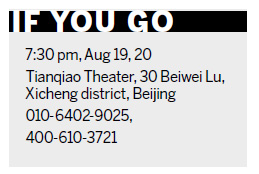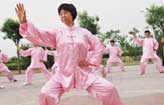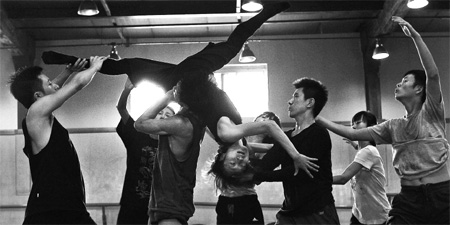Art
A different feeling
Updated: 2011-08-19 07:58
By Chen Nan (China Daily)
|
Dancers in Offering and Fragrance rehearse at a small, non-air-conditioned rehearsal room so, "I can feel my body's reaction as I sweat", says dancer-choreographer Gao Yanjinzi. Zou Hong / China Daily |
 |
Choreographer Gao Yanjinzi is confident her latest work, Offering and Fragrance, will finally help Chinese audiences understand modern dance. Chen Nan reports.
Where once dancer-choreographer Gao Yanjinzi tried "to answer my own questions about dance", she now mulls complex philosophical thoughts such as "why are we here and what is life all about?" Beijing Modern Dance Company's artistic director says her latest work is a journey of self-discovery, deeply influenced by Buddhist and Zen ideas.
The production premiered at the National Center for the Performing Arts this May and will now be staged at Tianqiao Theater.
Offering and Fragrance comprises two individual dance works, Fragrance and Shape Talk and Water Asking. The former reflects the 35-year-old dancer's ideas about materialism and its impact on society, while the latter dwells on the state of spirituality in today's world.
The choreographer uses fragrance and flowing water to represent the pressure on people today and their elusive spirituality.
Offering and Fragrance, she says, is a work dedicated to the 15th birth anniversary of Beijing Modern Dance Company. Referring candidly to reviews of her works over the past 15 years, which say that while audiences are impressed with the presentation they make little sense of the dance itself, she says.
"I knew audiences would ask why and what dance is all about. In China today people are still trying to understand modern dance, and find it too abstract," she says.
"Offering and Fragrance might provide the answer. They will feel content What matters is not the meaning behind a piece of dance, but what the audience feels after watching it."
While Beijing Modern Dance Company, which was founded in 1995, has earned itself a respectable reputation abroad, it still struggles to promote this art form at home.
"We not only perform in China but also organize many public events to spread knowledge about modern dance," Gao says.
As one of the founders of the company, she says modern dance is widely misunderstood by Chinese audiences. Some view it as extremely abstract, some as hip-hop, and yet others as some kind of street dance.
"I hope this dance work will lead Chinese into the world of modern dance. The dance can be slow, energetic, or intense. Whatever it looks like, I want the audience to feel and enjoy it," she says.
Gao says she feels content when challenging and communicating with her body.
She prefers a small, non-air-conditioned rehearsal room so, "I can feel my body's reaction as I sweat".
The Beijing Dance Academy graduate took to dancing in her childhood and rose to fame, drawing on her Buddhist background and traditional Chinese dance training. Her dancers inhabit a contemplative, harmonious world, moving with a natural energy. Yet surprises lurk at every turn, challenging audiences' views of a binary world - traditional and modern, East and West.
She has received numerous awards for performances and choreography both in China and abroad, including the Grand Prix at the 12th International Modern Choreography Competition in Belarus for her piece, Worlds (1999).
Her work Jue-Aware bagged the Danza e Danza award for best performance in 2006, from Italy's leading dance magazine, Danza e Danza.
As a choreographer, she says she is firm with her dancers, but they also have the freedom to improvise.
The idea of freedom is dear to the Guizhou-born artist, and its most fluent expression is found in her choreography.
"Modern dance can be inspired by anything in our Chinese culture, from calligraphy, taichi, to folk art and religion," she says.
E-paper

Going with the flow
White-collar workers find a traditional exercise helps them with the frustrations of city life
The light touch
Long way to go
Outdoor success
Specials

Star journalist remembered
Friends, colleagues attended a memorial service to pay tribute to veteran reporter Li Xing in US.

Robots seen as employer-friendly
Robots are not new to industrial manufacturing. They have been in use since the 1960s.

A prosperous future
Wedding website hopes to lure chinese couples

